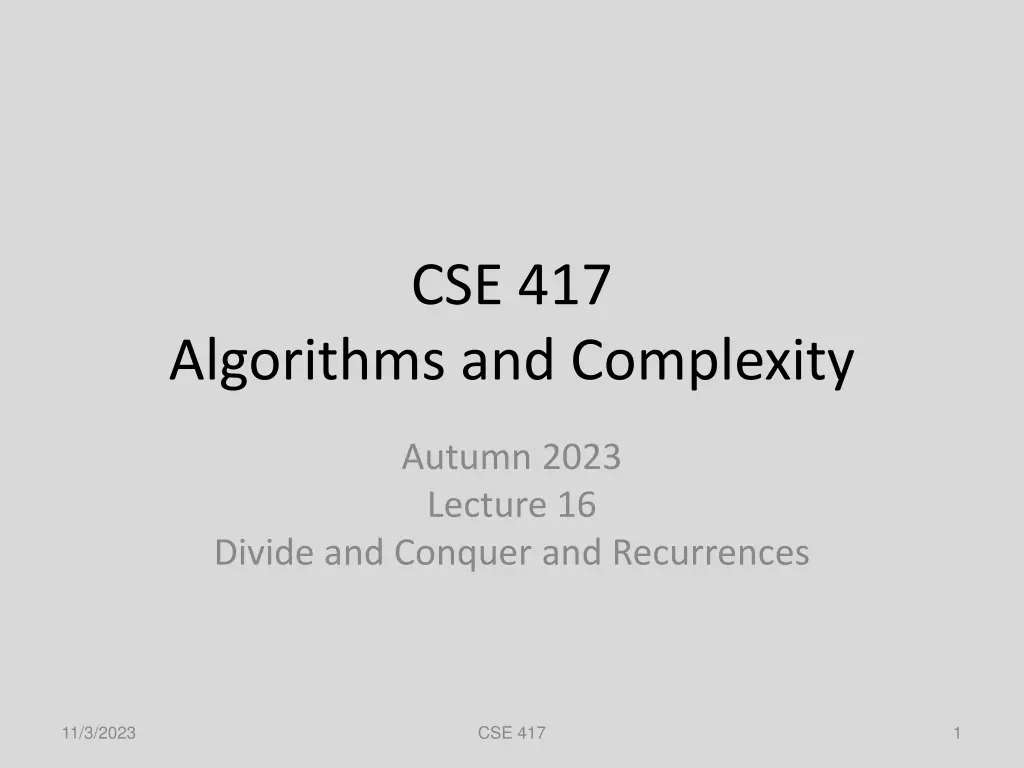
Understanding Divide and Conquer Techniques in Algorithms
Explore the concepts of divide and conquer, recurrences, and solving algorithms. Learn about Merge Sort, fast matrix multiplication, counting inversions, and more in the context of algorithm complexity. Dive into solving recurrences and uncover the three basic behaviors that dictate algorithmic depth.
Download Presentation

Please find below an Image/Link to download the presentation.
The content on the website is provided AS IS for your information and personal use only. It may not be sold, licensed, or shared on other websites without obtaining consent from the author. If you encounter any issues during the download, it is possible that the publisher has removed the file from their server.
You are allowed to download the files provided on this website for personal or commercial use, subject to the condition that they are used lawfully. All files are the property of their respective owners.
The content on the website is provided AS IS for your information and personal use only. It may not be sold, licensed, or shared on other websites without obtaining consent from the author.
E N D
Presentation Transcript
CSE 417 Algorithms and Complexity Autumn 2023 Lecture 16 Divide and Conquer and Recurrences 11/3/2023 CSE 417 1
Divide and Conquer Recurrences, Sections 5.1 and 5.2 Algorithms Median (Selection) Fast Matrix Multiplication Counting Inversions (5.3) Multiplication (5.5) 11/3/2023 CSE 417 2
Divide and Conquer : Merge Sort Array MSort(Array a, int n){ if (n <= 1) return a; return Merge(MSort(a[0 .. n/2], n/2), MSort(a[n/2+1 .. n-1], n/2); } T(n) = 2T(n/2) + n; T(1) = 1; 11/3/2023 CSE 417 3
Unrolling the recurrence 11/3/2023 CSE 417 4
T(n) = 2T(n/2) + n; T(1) = 1; Substitution Prove T(n) n (log2n + 1) for n 1 Induction Show P(1) and Base Case: T(1) = 1 = 1 (log2 1 + 1) Induction: Assume T(n/2) n/2 (log2(n/2) + 1) T(n) = 2 T(n/2) + n 2 n/2 (log2(n/2) + 1) + n = n (log2 n 1 + 1) + n = n (log2 n + 1) 11/3/2023 CSE 417 5
T(n) = aT(n/b) + nc 11/3/2023 CSE 417 6
T(n) = T(n/2) + cn Where does this recurrence arise? 11/3/2023 CSE 417 7
Solving the recurrence exactly 11/3/2023 CSE 417 8
Total Work T(n) = 4T(n/2) + n n n/2 n/2 n/2 n/2 n/4 n/4 n/4 n/4 n/4 n/4 n/4 n/4 n/4 n/4 n/4 n/4 n/4 n/4 n/4 n/4 11/3/2023 CSE 417 9
T(n) = 2T(n/2) + n2 11/3/2023 CSE 417 10
T(n) = 2T(n/2) + n1/2 11/3/2023 CSE 417 11
Recurrences Three basic behaviors Dominated by initial case Dominated by base case All cases equal we care about the depth 11/3/2023 CSE 417 12
Geometric Sum 11/3/2023 CSE 417 13
What you really need to know about recurrences Work per level changes geometrically with the level Geometrically increasing (x > 1) The bottom level wins Geometrically decreasing (x < 1) The top level wins Balanced (x = 1) Equal contribution 11/3/2023 CSE 417 14
Classify the following recurrences (Increasing, Decreasing, Balanced) T(n) = n + 5T(n/8) T(n) = n + 9T(n/8) T(n) = n2 + 4T(n/2) T(n) = n3 + 7T(n/2) T(n) = n1/2 + 3T(n/4) 11/3/2023 CSE 417 15
Recursive Matrix Multiplication Multiply 2 x 2 Matrices: | r s | | a b| |e g| | t u | | c d| | f h| A N x N matrix can be viewed as a 2 x 2 matrix with entries that are (N/2) x (N/2) matrices. = The recursive matrix multiplication algorithm recursively multiplies the (N/2) x (N/2) matrices and combines them using the equations for multiplying 2 x 2 matrices r = ae + bf s = ag + bh t = ce + df u = cg + dh 11/3/2023 CSE 417 16
Recursive Matrix Multiplication How many recursive calls are made at each level? How much work in combining the results? What is the recurrence? 11/3/2023 CSE 417 17
What is the run time for the recursive Matrix Multiplication Algorithm? Recurrence: 11/3/2023 CSE 417 18
Strassens Algorithm Where: Multiply 2 x 2 Matrices: | r s | | a b| |e g| | t u| | c d| | f h| p1 = (b d)(f + h) p2= (a + d)(e + h) p3= (a c)(e + g) p4= (a + b)h p5= a(g h) p6= d(f e) p7= (c + d)e = r = p1 + p2 p4 + p6 s = p4 + p5 t = p6 + p7 u = p2 - p3 + p5 - p7 From AHU 1974 11/3/2023 CSE 417 19
Recurrence for Strassens Algorithms T(n) = 7 T(n/2) + cn2 What is the runtime? 11/3/2023 CSE 417 20 log2 7 = 2.8073549221
